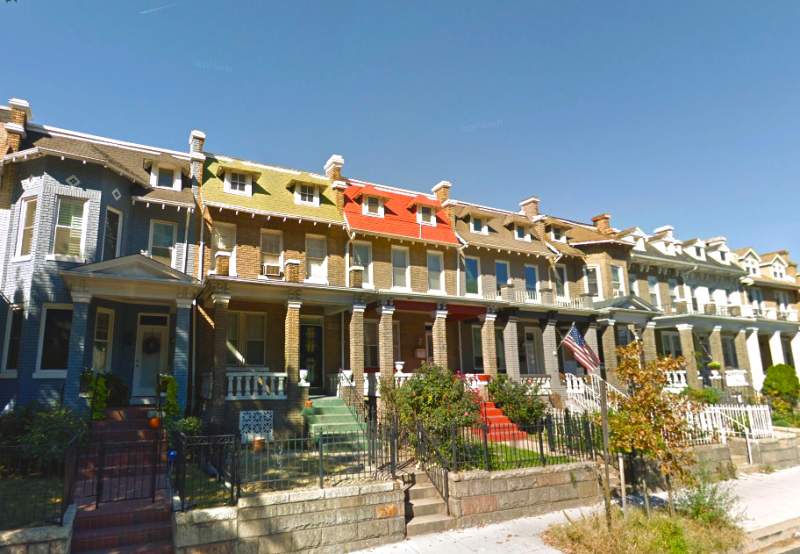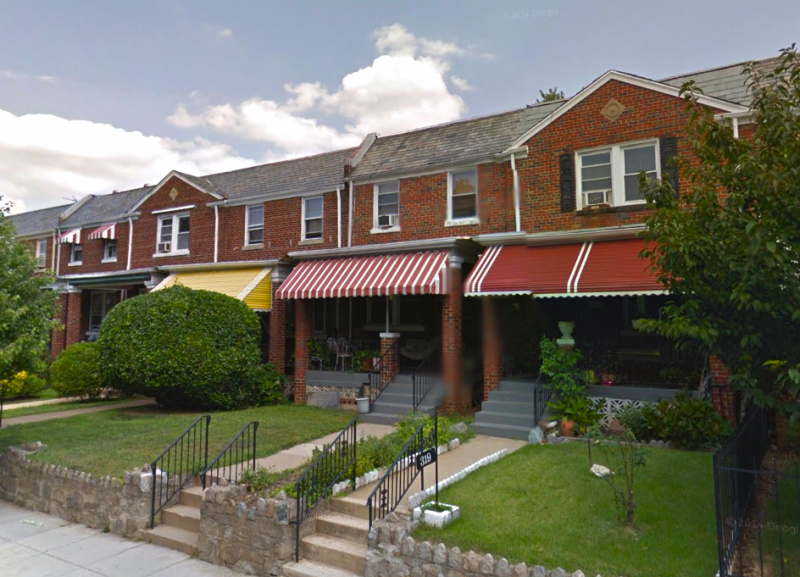What’s a historic district, anyway?

Bloomingdale rowhouses. Created with Google Maps.
This article was first published on January 8, 2018. We thought the article was still relevant and wanted to share it again.
In the next few months, two DC neighborhoods will be considered for designation as historic districts: Kingman Park and Bloomingdale. Here’s some background on what that actually means for those who live in those neighborhoods.
What is a historic district?
DC law actually provides for two types of historic designations: historic landmark status for individual properties (or small groups of related properties) and historic districts for broader sets of properties in a geographically bounded area (usually a neighborhood). The fundamental protections are fairly similar between these; the difference is just a building-by-building versus a neighborhood district approach.
Properties within historic districts are subject to additional regulations and review for new construction, demolitions, exterior alterations that require a permit, or subdivisions. In other words, you can replant your garden, knock down an interior wall, or do anything else that does not require a permit from the city. However, if you want to replace your windows, redo your roof, build new front steps or a basement entrance, add an extra floor or garage, or do anything that changes the exterior of the building that requires a city permit, you must go through the historic review process first.
It is important to note that not all buildings in historic districts are considered “contributing structures,” which are buildings that add to the historical integrity of the district. If you live in a non-contributing structure in the bounds of a historic district, your regulations might be less rigorous than those for your contributing structure neighbor. However, changes still must be “compatible.”
DC currently has more than 50 historic districts, over 30 of which are local neighborhoods. Military sites, campuses, cemeteries, parks, and parkways make up the rest.
DC's historic districts, as of 2014. Image by DC Office of Planning.
What do these regulations actually mean?
The broad goal of the city’s historic protection laws is “to ensure that work done on historic properties is compatible with their historic character.” That compatibility is primarily determined by staff members of the Historic Preservation Office (HPO) — who review standard permits — and the Historic Preservation Review Board (HPRB), a nine-member committee of historic preservation experts appointed by the mayor.
While compatibility is a broad term encompassing numerous factors (massing, size, scale, architectural elements, etc.) that often come down to the opinion of HPO/HPRB, there are some specific requirements (like lists of approved vs. unapproved materials that can be used) that are more straightforward.
HPRB has published design guidelines for many common types of construction and alteration to help lay out those recommendations in advance. One of the most common homeowner interactions with preservation is for windows. Old houses often have wood window frames, and HPO requires any new windows to be one of a few compatible types which are more expensive than the windows you can get at Home Depot.
Bloomingdale rowhouses. Created with Google Maps. 
In general, HPO/HPRB do not allow significant additions to properties in historic districts that would be visible from the street in front, such as additional floors. While the current zoning laws require zoning review and a public hearing for most added floors, in a historic district, any such addition would also have to be set far enough back from the front that it’s not visible to someone standing on the sidewalk immediately opposite.
HPO/HPRB also reviews new construction in historic districts, which can be built on empty lots or replace non-contributing buildings. They often set requirements for what materials can be used or limit the number of floors beyond what zoning requires. However, HPO/HPRB generally do not require (and even forbid) a building that looks the same as old ones. They think faux-historic buildings look fake, and instead insist that new buildings look modern.
How do neighborhoods become historic?
Historic designation starts with an application to the HPRB. This can be filed by the board itself, a public agency, government department, or, more commonly, an ANC or a historic preservation organization (which does not have to be based in the area being nominated).
An application lays out the case for preservation by citing the narrative history, historic events and individuals connected to the neighborhood, and architectural significance of the buildings in the district, among other elements.
Kingman Park houses. Created with Google Maps. 
If HPO staff determine the application is complete, they officially file it and schedule a hearing at an upcoming HPRB meeting, giving public notice at least 30 days out of the hearing date. That 30 days then becomes the official public comment period. Any interested persons can submit public comments during this period and testify during the hearing.
At the hearing, HPRB can then vote to either designate the district historic or deny the application. They can also choose to defer the designation or designate with reduced boundaries. They cannot choose to expand the boundaries without new notice and a new hearing.
How is community opinion factored in?
This is actually a point of some contention. The relevant provisions in DC law specify that:
“The views of property owners and the general public are essential to informed decisionmaking in the historic preservation process”
and
“The officially adopted written views of Advisory Neighborhood Commissions shall be accorded great weight in the historic preservation process”
However, the Office of Planning (OP) only describes community support as “beneficial” to an application, while noting that “by law, HPRB makes its decision on the basis of the written designation criteria.”
That ambiguity doesn’t present any real problems when community opinion is clearly in support of a historic application, but what does HPRB do when a majority of neighbors are opposed?
Historically, they’ve been able to avoid the question — in large part because those cases have rarely come before the review board at all. Community opposition has either led to applicants withdrawing their application or dissuaded interested parties from filing an application in the first place. This “self-policing” explains why, according to commissioner ANC 7D01 (Kingman Park) Commissioner Robert Coomber, Kim Williams of HPO told him that in her tenure at the organization, HPRB had never denied an application for historic designation.
Kingman Park. Created with Google Maps. 
This issue of community support has surfaced in past historic district applications. In 2008, an organization called Historic Chevy Chase formed to apply for historic designation for that neighborhood. The ensuing community outreach ignited a firestorm of debate, and after the ANC passed a resolution not in favor, the historic district application was never submitted.
In a similar fashion in 2016 in Eckington, the local civic association followed these recommendations and did an extensive amount of public outreach before even officially filing their application. Ultimately, a strong majority of neighbors attending the civic association meeting on this issue voted against pursuing historic designation, so the application was never filed.
This question might again be put to the test in the upcoming reviews of Kingman Park and Bloomingdale. In both cases the applications have already been filed, and in both cases there are signs that broad support for historic designation might not exist. In Kingman Park, a number of neighbors have been actively petitioning OP with their concerns, saying that the application was moved along by a small group of neighbors who did not do enough public outreach. Similarly, I am part of a growing group of Bloomingdale residents that have concerns.
Kingman Park’s application is scheduled for review in just a few weeks, while Bloomingdale will likely be considered in the next few months.
